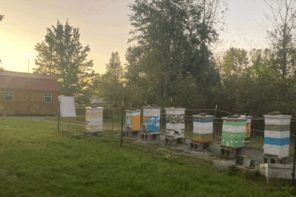By: Kim Flottum
This article originally appeared in the Autumn 2017 issue of BEEKeeping Your First Three Years
By now your package should be on its way, with some comb drawn out, eggs, open and maybe even sealed brood apparent in some of the frames. For a brand new package, everything they collect they immediately turn into food for the young or wax for storage and nursery space. They are absolutely living hand to mouth this summer. Five days of rain could actually mean starvation to a colony that’s really on the edge right now with lots of brood to feed, so your tasks are well defined. Don’t let that happen.
One thing to recall with a package is that you start with, say 10,000 bees, minus a few, the day you install them. That day a bunch die of old age, chilled, or injured in the melee of dumping. The next day, more do the same. And the next and the next and the next. Although package producers try and shake bees from the center of the nest so they are the youngest, they get a mix and the old and injured begin to die, right after they get weighed in the field.
Your queen waits a respectable week to 10 days before she begins to lay eggs, and if all goes well, she is laying several hundred a day after a week, and pushing a thousand a day after a month. But, and this is important, that first egg isn’t an adult for 3 weeks, or a forager for four weeks. It’s a full month before new foragers take over, and in that month more than half of your original package expires. So it’s fewer and fewer bees taking care of more and more brood. I hope you can sense the urgency in the colony, and I hope you can see your task here relative to making sure this colony has all the food it needs and then some.
This scenario also occurs when you get a nuc for a starter colony, but it’s not quite panic city because, or at least maybe, your nuc supplier included a healthy laying queen, enough workers to take care of the brood in the nuc and do some foraging, several drawn combs for food and brood, and enough food to cover a few off days of rain. But again, your chores are well defined. Don’t let them starve in the midst of plenty.
There is probably lots of available food for them to harvest. Early sources like dandelions are already gone, but you still have lindens, clovers and goldenrod are beginning to bloom now and supplying lots of food. But again, everything they harvest turns into wax or brood food so they just don’t have a huge surplus to draw from should the weather turn sour.
So. Feeding is the task to most focus on right now. Making sure there is always, always food available for those rainy days. I typically recommend this …
Keep feeding 1:1 (one part sugar, one part water, with a teaspoon/gallon Honey Bee Healthy or similar feeding stimulant) until the third batch has fermented. If in doubt, taste it…if it’s a tad sour to you, and your bees won’t like it. Third. Not second or first. Third. At the same time, don’t forget protein. If it’s raining, they’ll get neither nectar or pollen and they need both. So if you don’t have natural, trapped pollen to feed, give them a protein supplement patty. You have to watch these carefully however, depending on where you are located and how much pressure small hive beetle plays here. Female beetles like laying eggs in the patty and the larvae simply love eating them when they hatch, so if you neglect to watch, you can raise a whole slew of these obnoxious pests. If you find a patty…I’d recommend using a half patty at a time…with larvae in it remove and discard, or better feed to your chickens, who will thank you for the treat.
Your colony’s first year is playing catch up and getting ready, and a honey surplus usually isn’t in the game. Yes, they may make enough honey to fill a box, but recall they will need that honey for overwintering. Don’t be surprised if you are still feeding in the middle of July. One easy way to justify this is the cost of that package. If you neglect to feed and they starve this coming Winter, how much to replace that colony? That much? Sugar is cheap in comparison.
At the same time, don’t underestimate how much room they will need to put all this stuff away. In most places, most years, most beekeepers will put a second deep super, if you are using deep supers on by the middle or end of July. Maybe sooner if all is going well. That super, too, needs all of the wax supplied by the food the bees are…bringing in, or are getting fed. Either way, it’s another box or wax that has to come from somewhere. So now you have a stack of boxes…what, four high? Three anyway. And that stack is getting heavier every day. How stable is your hive stand? How level? How solid is the ground? If you have stands like I do, large enough to hold three colonies, but only holding two, you can have four or five hundred pounds of wood, wax, bees and honey on that stand. Is it strong enough, level enough, protected enough?
Finding a hive stand tipped over some Saturday morning means a really bad day ahead, for you, the bees, maybe your family and neighbors. So before your colonies get so heavy they start straining your stand…double check to make sure.









